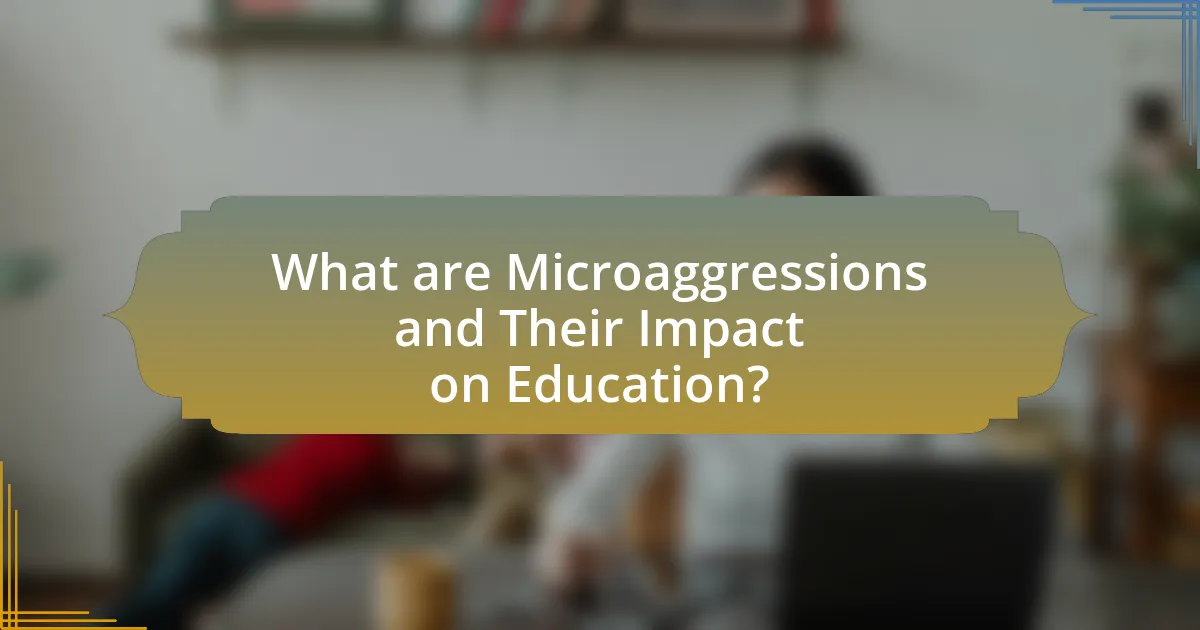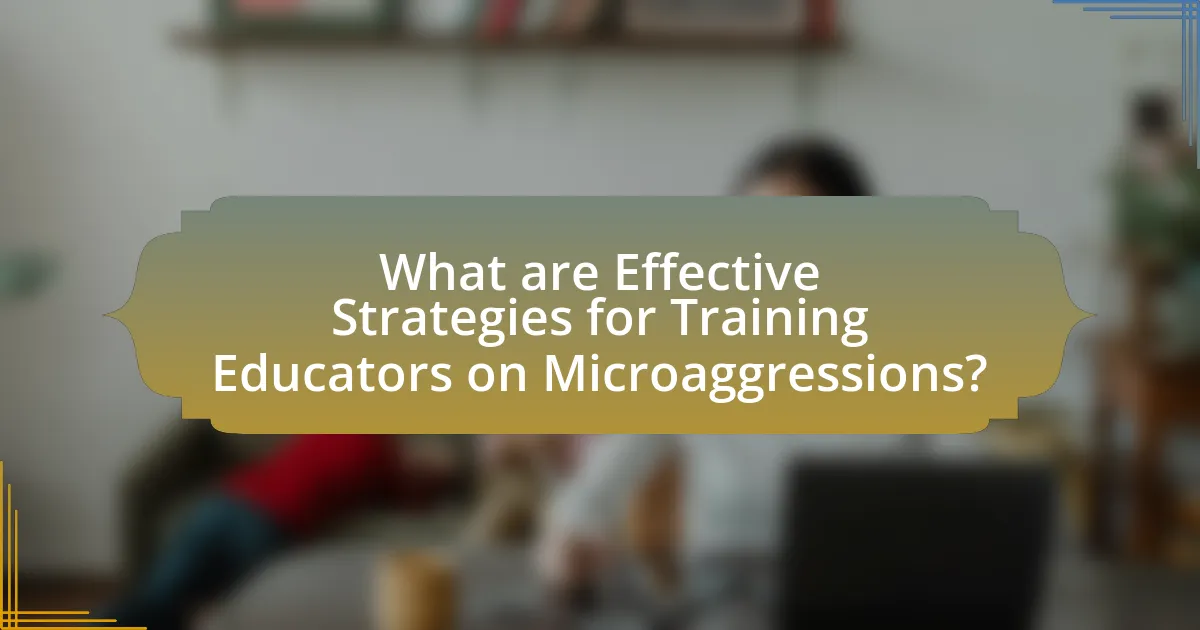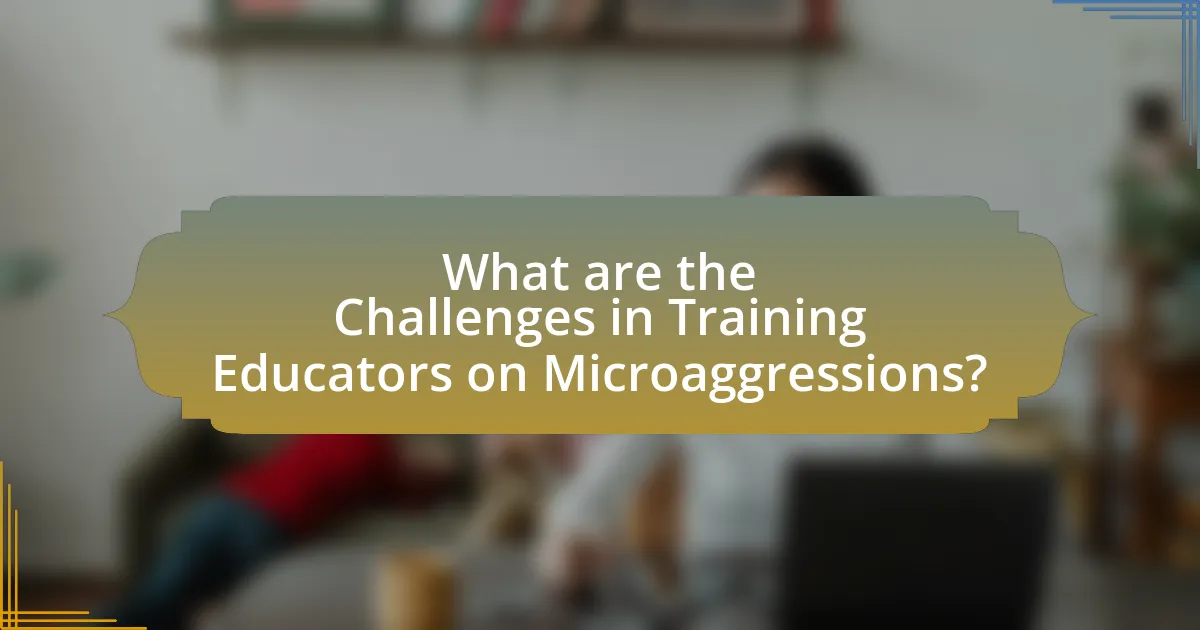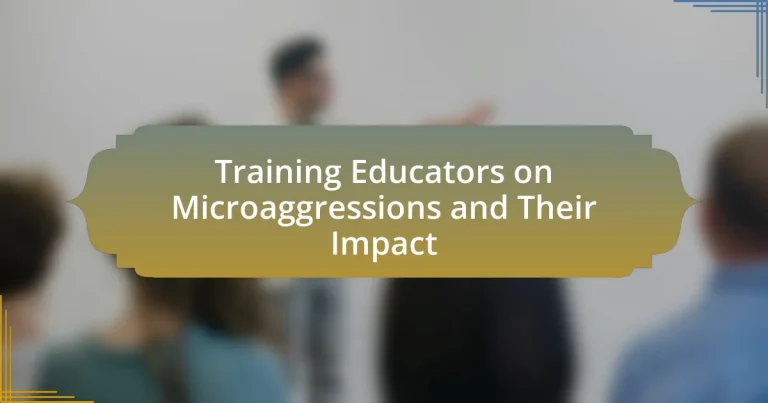Microaggressions are subtle, often unintentional comments or actions that convey negative messages toward marginalized groups, significantly impacting students’ psychological well-being and academic performance in educational settings. This article explores how microaggressions manifest in classrooms, their detrimental effects on student mental health and engagement, and the critical role educators play in recognizing and addressing these behaviors. It outlines effective strategies for training educators, including interactive workshops and ongoing professional development, to foster a more inclusive learning environment. Additionally, the article discusses challenges in training, the importance of student feedback, and best practices for implementing comprehensive training programs on microaggressions in schools.

What are Microaggressions and Their Impact on Education?
Microaggressions are subtle, often unintentional, comments or actions that convey derogatory or negative messages toward marginalized groups. In the context of education, microaggressions can significantly impact students’ psychological well-being, academic performance, and overall school experience. Research indicates that students who experience microaggressions may face increased stress, lower self-esteem, and a diminished sense of belonging, which can hinder their engagement and success in educational settings. For instance, a study published in the Journal of Educational Psychology found that students of color reported feeling alienated and less motivated due to microaggressive remarks from peers and educators. This highlights the necessity for training educators to recognize and address microaggressions to foster a more inclusive and supportive learning environment.
How do microaggressions manifest in educational settings?
Microaggressions in educational settings manifest through subtle, often unintentional comments or behaviors that convey derogatory or negative messages to marginalized groups. These can include remarks about a student’s intelligence based on their racial or ethnic background, assumptions about a student’s abilities linked to their gender, or dismissive comments regarding a student’s cultural practices. Research indicates that such microaggressions can lead to a hostile learning environment, negatively impacting students’ academic performance and mental health. For instance, a study published in the Journal of Educational Psychology found that students who experienced microaggressions reported lower levels of engagement and higher levels of stress, illustrating the detrimental effects of these interactions on educational outcomes.
What are common examples of microaggressions faced by students?
Common examples of microaggressions faced by students include comments that imply a lack of belonging, such as “You speak English really well” directed at non-native speakers, which suggests that they are not expected to be proficient. Another example is when students of color are frequently asked, “Where are you really from?” implying that they are not truly part of the community. Additionally, statements like “You’re so articulate” can unintentionally convey surprise that a person of a certain background can express themselves well. These microaggressions can contribute to feelings of alienation and undermine students’ confidence, as highlighted in research by Sue et al. (2007) in the Journal of Personality and Social Psychology, which discusses the cumulative impact of microaggressions on marginalized groups.
How do microaggressions affect student mental health and academic performance?
Microaggressions negatively impact student mental health and academic performance by contributing to increased stress, anxiety, and feelings of alienation. Research indicates that students who experience microaggressions report higher levels of psychological distress, which can lead to decreased motivation and engagement in academic activities. For instance, a study published in the Journal of Counseling Psychology found that microaggressions are linked to lower academic achievement and higher dropout rates among marginalized students. This correlation underscores the importance of addressing microaggressions in educational settings to foster a supportive learning environment.
Why is it important for educators to understand microaggressions?
It is important for educators to understand microaggressions because these subtle, often unintentional comments or behaviors can significantly impact students’ emotional well-being and academic performance. Research indicates that microaggressions contribute to a hostile learning environment, leading to decreased student engagement and increased feelings of alienation among marginalized groups. For instance, a study published in the Journal of Educational Psychology found that students who experienced microaggressions reported lower levels of academic motivation and higher levels of stress. By recognizing and addressing microaggressions, educators can foster an inclusive atmosphere that promotes equity and supports all students’ success.
What role do educators play in addressing microaggressions?
Educators play a crucial role in addressing microaggressions by fostering an inclusive environment and promoting awareness among students. They are responsible for recognizing microaggressions in the classroom and intervening to educate students about their impact. Research indicates that when educators receive training on microaggressions, they can effectively identify and address these subtle forms of discrimination, leading to a more supportive learning atmosphere. For instance, a study published in the Journal of Educational Psychology found that teacher training programs that include discussions on microaggressions significantly improve educators’ ability to respond to such incidents, thereby enhancing student well-being and academic performance.
How can understanding microaggressions improve classroom dynamics?
Understanding microaggressions can improve classroom dynamics by fostering a more inclusive and respectful environment. When educators recognize and address microaggressions, they can mitigate feelings of alienation among students, which research indicates can lead to increased engagement and participation. A study published in the Journal of Educational Psychology found that students who perceive their classroom as inclusive are more likely to perform better academically and exhibit positive social behaviors. By training educators to identify and respond to microaggressions, schools can create a supportive atmosphere that enhances learning outcomes and promotes equity among diverse student populations.

What are Effective Strategies for Training Educators on Microaggressions?
Effective strategies for training educators on microaggressions include implementing interactive workshops, utilizing real-life scenarios, and fostering open discussions. Interactive workshops engage educators actively, allowing them to practice recognizing and addressing microaggressions in a safe environment. Real-life scenarios provide context, helping educators understand the impact of microaggressions on students’ experiences. Open discussions create a space for educators to share personal experiences and reflect on their biases, promoting a deeper understanding of the issue. Research indicates that such experiential learning approaches significantly enhance awareness and responsiveness to microaggressions among educators, leading to a more inclusive educational environment.
What training methods are most effective for educating teachers about microaggressions?
Interactive workshops are the most effective training method for educating teachers about microaggressions. These workshops facilitate active participation, allowing educators to engage in role-playing scenarios and discussions that highlight the nuances of microaggressions in educational settings. Research indicates that experiential learning, such as through workshops, significantly enhances understanding and retention of complex social issues, including microaggressions. A study by Sue et al. (2009) emphasizes that direct engagement in discussions about microaggressions leads to greater awareness and sensitivity among educators, ultimately fostering a more inclusive classroom environment.
How can workshops and seminars be structured to maximize impact?
Workshops and seminars can be structured to maximize impact by incorporating interactive elements, clear objectives, and diverse teaching methods. Interactive elements, such as group discussions and role-playing, engage participants and enhance retention of information. Clear objectives ensure that all activities align with the desired outcomes, allowing participants to understand the relevance of the content. Diverse teaching methods, including multimedia presentations and hands-on activities, cater to different learning styles, making the material more accessible. Research indicates that active learning strategies can improve knowledge retention by up to 75%, demonstrating the effectiveness of these structured approaches in educational settings.
What role does ongoing professional development play in this training?
Ongoing professional development is essential in training educators on microaggressions and their impact, as it ensures that educators remain informed about the evolving understanding of microaggressions and their effects on students. Continuous learning opportunities allow educators to refine their skills, adopt new strategies, and engage in reflective practices that enhance their ability to recognize and address microaggressions in the classroom. Research indicates that educators who participate in ongoing professional development are better equipped to create inclusive environments, leading to improved student outcomes and a reduction in instances of microaggressions.
How can educators apply their training in real-world scenarios?
Educators can apply their training on microaggressions in real-world scenarios by implementing inclusive teaching practices that actively address and mitigate biases in the classroom. For instance, they can create a safe environment for open discussions about diversity and inclusion, allowing students to express their experiences with microaggressions. Research indicates that when educators are trained to recognize and respond to microaggressions, they can significantly improve student engagement and academic performance, as highlighted in the study “Microaggressions in the Classroom: A Study of Teacher Responses” by Sue et al. (2016). This demonstrates that effective application of training leads to a more equitable learning environment.
What practical tools can educators use to identify and address microaggressions?
Educators can use reflective practices, training workshops, and feedback mechanisms as practical tools to identify and address microaggressions. Reflective practices involve educators regularly assessing their own biases and interactions with students, which can help in recognizing subtle forms of discrimination. Training workshops provide structured environments where educators learn about microaggressions, their impact, and strategies for intervention, enhancing their awareness and responsiveness. Feedback mechanisms, such as anonymous surveys or open discussions, allow students to share their experiences, enabling educators to identify patterns of microaggressions and address them effectively. These tools collectively foster a more inclusive educational environment.
How can educators create a more inclusive classroom environment?
Educators can create a more inclusive classroom environment by implementing training programs focused on recognizing and addressing microaggressions. Such training equips educators with the skills to identify subtle, often unintentional discriminatory comments or behaviors that can negatively impact students’ learning experiences. Research indicates that microaggressions can lead to decreased academic performance and increased feelings of alienation among marginalized students (Sue et al., 2007). By fostering awareness and promoting open dialogue about these issues, educators can cultivate a supportive atmosphere that values diversity and encourages all students to participate fully.

What are the Challenges in Training Educators on Microaggressions?
Training educators on microaggressions faces several challenges, primarily due to the complexity of the subject and the emotional responses it elicits. One significant challenge is the lack of awareness among educators about what constitutes microaggressions, as many may not recognize subtle forms of bias in their interactions. Additionally, educators often have varying levels of comfort discussing race, gender, and identity issues, which can hinder open dialogue and learning. Resistance to change is another obstacle; some educators may feel defensive or dismissive when confronted with their own biases, making it difficult to foster a constructive training environment. Furthermore, the absence of standardized training programs means that the quality and effectiveness of training can vary widely, leading to inconsistent outcomes. Research indicates that effective training requires ongoing support and reinforcement, yet many programs are one-time events that fail to create lasting change.
What resistance might educators face when learning about microaggressions?
Educators may face resistance in learning about microaggressions due to a lack of awareness or understanding of the concept. Many educators might not recognize microaggressions as harmful behaviors, viewing them instead as benign or unintentional comments. This misunderstanding can lead to defensiveness when confronted with the idea that their actions may perpetuate bias or discrimination. Additionally, educators may resist acknowledging their own biases, as this can challenge their self-perception and professional identity. Research indicates that individuals often exhibit cognitive dissonance when faced with information that contradicts their beliefs, which can further hinder their willingness to engage with the topic of microaggressions.
How can facilitators address misconceptions about microaggressions?
Facilitators can address misconceptions about microaggressions by providing clear definitions and examples that illustrate their subtle nature and impact. Research indicates that microaggressions are often unintentional and can perpetuate stereotypes, leading to negative psychological effects on marginalized groups. For instance, a study by Sue et al. (2007) highlights how microaggressions can contribute to a hostile environment for individuals from diverse backgrounds. By incorporating interactive discussions and role-playing scenarios, facilitators can help participants recognize and reflect on their own biases, fostering a deeper understanding of how microaggressions manifest in everyday interactions. This approach not only clarifies misconceptions but also encourages empathy and awareness among educators.
What strategies can be employed to foster open discussions about sensitive topics?
To foster open discussions about sensitive topics, educators can implement strategies such as creating a safe environment, using active listening techniques, and establishing ground rules for respectful dialogue. A safe environment encourages participants to share their thoughts without fear of judgment, which is crucial when discussing microaggressions and their impact. Active listening techniques, such as paraphrasing and summarizing, help ensure that all voices are heard and understood, promoting a more inclusive conversation. Establishing ground rules, like maintaining confidentiality and respecting differing opinions, further supports a constructive dialogue. Research indicates that these strategies can significantly enhance communication and understanding in educational settings, particularly when addressing complex issues like microaggressions (Sue et al., 2007, “Microaggressions in Everyday Life: Race, Gender, and Sexual Orientation”).
How can schools measure the effectiveness of microaggression training?
Schools can measure the effectiveness of microaggression training through pre- and post-training surveys that assess changes in awareness, attitudes, and behaviors regarding microaggressions. These surveys can include quantitative metrics, such as Likert scale questions, and qualitative feedback to gauge participants’ understanding and application of concepts learned. Research indicates that effective training programs often show a statistically significant increase in participants’ ability to identify microaggressions and respond appropriately, as evidenced by studies like “Microaggressions in Everyday Life” by Derald Wing Sue, which highlights the importance of awareness in reducing microaggressive behaviors. Additionally, schools can track incidents of reported microaggressions before and after training to evaluate any decrease in occurrences, providing concrete data on the training’s impact.
What metrics can be used to assess changes in educator behavior?
Metrics that can be used to assess changes in educator behavior include classroom observation scores, self-reported surveys, student feedback, and professional development participation rates. Classroom observation scores provide direct evidence of instructional practices and interactions, while self-reported surveys can gauge educators’ perceptions of their own behavior changes. Student feedback offers insights into the impact of educator behavior on learning environments, and professional development participation rates indicate engagement with training on microaggressions. Research shows that these metrics can effectively capture shifts in educator behavior, as evidenced by studies linking improved observation scores to targeted training interventions.
How can feedback from students inform the training process?
Feedback from students can significantly inform the training process by identifying specific areas where educators may unintentionally perpetuate microaggressions. This feedback allows trainers to tailor their programs to address these issues directly, enhancing the effectiveness of the training. For instance, a study by Sue et al. (2007) highlights that student experiences and perceptions can reveal patterns of microaggressions that educators may not be aware of, thus providing concrete examples for training sessions. By incorporating this feedback, training can become more relevant and impactful, ultimately fostering a more inclusive educational environment.
What are Best Practices for Implementing Microaggression Training in Schools?
Best practices for implementing microaggression training in schools include integrating the training into existing professional development programs, ensuring it is evidence-based, and fostering an inclusive environment. Integrating training into professional development allows educators to contextualize microaggressions within their daily interactions, enhancing relevance and application. Evidence-based approaches, such as those outlined in the research by Sue et al. (2007), demonstrate the effectiveness of targeted training in reducing microaggressive behaviors. Additionally, fostering an inclusive environment encourages open dialogue and reflection, which is crucial for understanding the impact of microaggressions on students. This combination of strategies ensures that training is not only informative but also transformative, leading to a more supportive school culture.
How can schools develop a comprehensive training program?
Schools can develop a comprehensive training program by implementing a structured curriculum focused on microaggressions and their impact on students. This program should include workshops that educate educators about the definition, examples, and consequences of microaggressions, fostering an understanding of their subtle yet harmful effects on student well-being and academic performance. Research indicates that training programs that incorporate interactive elements, such as role-playing and discussions, significantly enhance educators’ awareness and responsiveness to microaggressions (Sue et al., 2009, “Microaggressions in Everyday Life: Race, Gender, and Sexual Orientation,” Wiley). Additionally, schools should establish ongoing support systems, such as peer mentoring and feedback mechanisms, to ensure that educators can continuously improve their skills in recognizing and addressing microaggressions in the classroom.
What resources are available for educators seeking to learn more about microaggressions?
Educators seeking to learn more about microaggressions can access a variety of resources, including academic journals, online courses, and workshops. For instance, the Journal of Educational Psychology publishes research articles that explore the impact of microaggressions in educational settings. Additionally, platforms like Coursera and edX offer online courses specifically focused on diversity, equity, and inclusion, which often cover microaggressions. Workshops conducted by organizations such as the Anti-Defamation League provide practical training on recognizing and addressing microaggressions in the classroom. These resources are designed to enhance educators’ understanding and equip them with strategies to foster inclusive environments.


